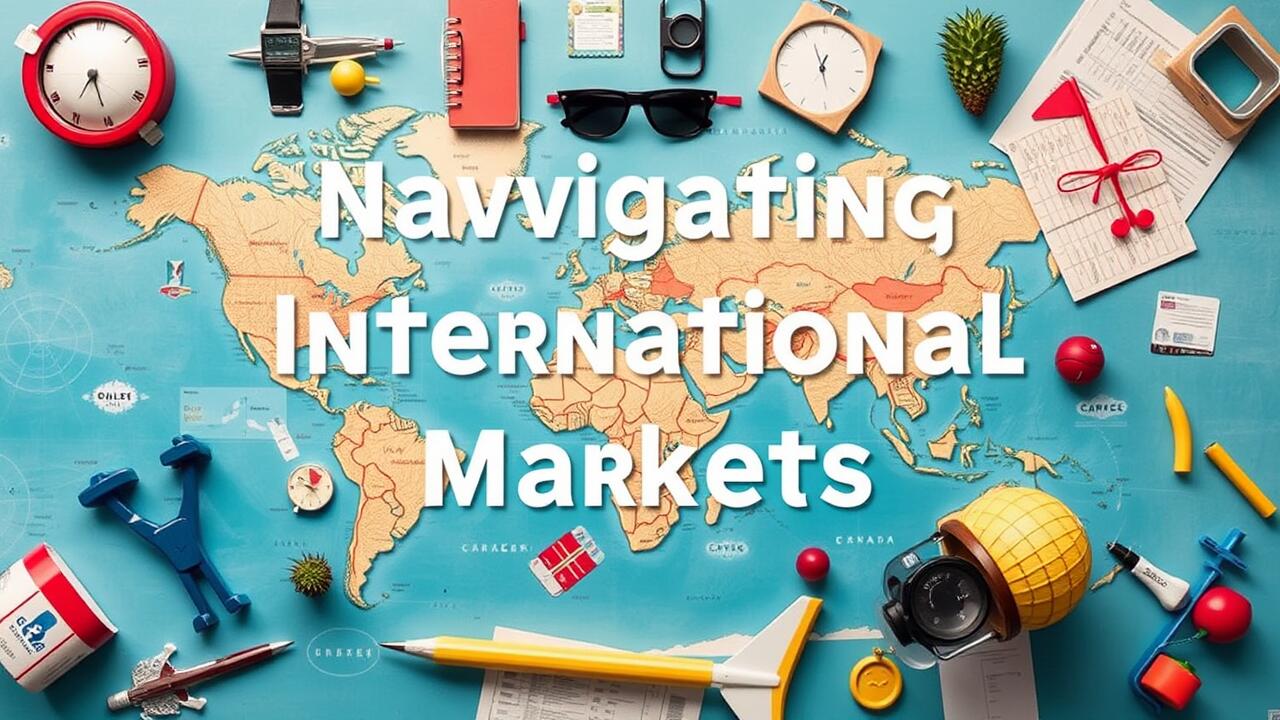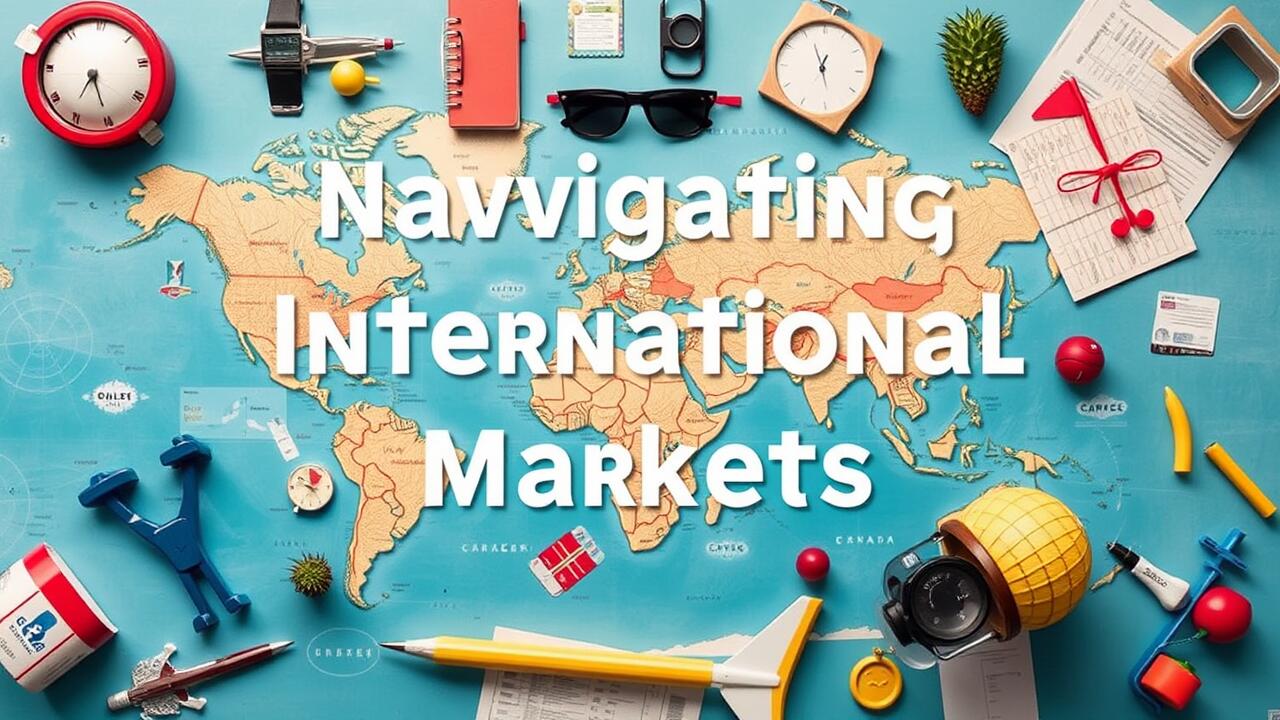Navigating International Markets: Top Export Strategies For 2024 With CITD
Table of Contents
- 1 Navigating International Markets: Top Export Strategies For 2024 With CITD | Understanding the Global Marketplace
- 2 Essential Export Strategies for 2024
- 3 The Role of CITD in Navigating International Markets
- 4 Identifying Target Markets
- 5 Building Strong International Relationships
- 6 Compliance and Regulations in Exporting
- 7 Conclusion
- 8 FAQS
- 8.1 What are the challenges faced by international experience companies when engaging in international trade and developing their global expansion efforts in competitive markets?
- 8.2 How can businesses effectively adapt pricing strategies in middle-income economies for successful international expansion in competitive markets?
- 8.3 How can companies adapt their pricing strategies to better position themselves in international trade within middle-income economies?
- 8.4 What strategies can companies utilize to enhance their operations in international trade, particularly in middle-income economies?
- 8.5 What are the key considerations for businesses looking to enter new markets in international trade, especially in middle-income economies?
- 8.6 How can businesses successfully navigate international trade in middle-income economies?
- 8.7 What are the benefits of engaging in international trade for companies operating in middle-income economies?
- 8.8 How can companies leverage opportunities in international trade within middle-income economies?
- 8.9 How can companies leverage opportunities in international trade san to improve their presence in middleincome economies?
Understanding the dynamics of international trade is crucial for businesses aiming to expand into global markets. Navigating International Markets: Top Export Strategies for 2024 with CITD emphasizes the importance of adapting to key trends that shape foreign investments and exporting practices. Companies must stay informed about export restrictions and import regulations, which can impact their competitiveness. The International Trade Administration provides valuable insights into these areas, helping businesses to make informed decisions regarding foreign direct investment (FDI). To leverage opportunities in global trade, firms should also engage with resources like the International Finance Corporation, which supports initiatives in enhancing market access and fostering sustainable growth. Navigating International Markets: Top Export Strategies for 2024 with CITD equips exporters with the tools necessary for success in an evolving economic landscape.

Key trends shaping international trade in 2024 reveal the importance of adapting to a rapidly changing global marketplace. Exporters must embrace digital transformation to enhance their competitiveness, especially as foreign investors increasingly seek opportunities within emerging markets. With the rise of global production networks, multinationals are refining their strategies for internationalization, opening new avenues for foreign investment. Navigating International Markets: Top Export Strategies for 2024 with CITD must focus on leveraging these trends to optimize export processes and improve market access.
Market dynamics are shifting as countries reinvigorate their trade policies and foster collaboration through international trade centres. Understanding these factors will be crucial for exporters aiming to position themselves strategically in a competitive landscape. With the potential for lucrative opportunities in various regions, businesses must not only analyze demand but also build robust partnerships that facilitate trade. Navigating International Markets: Top Export Strategies for 2024 with CITD emphasizes the need for exporters to remain agile and informed to successfully export their products in an evolving global environment.
Importance of Market Research in Export Strategy
Market research serves as a cornerstone for any robust export strategy, especially in the context of Navigating International Markets: Top Export Strategies for 2024 with CITD. Understanding the intricacies of foreign trade allows businesses to identify opportunities for export-led growth while navigating potential challenges such as import restrictions and import tariffs. A well-informed market entry strategy enhances the ability of multinational corporations and enterprises to maximize their exports through optimized global supply chains.
Analyzing market demand is crucial for choosing effective market entry strategies. Comprehensive research enables businesses to gauge consumer preferences, local competition, and regulatory hurdles specific to target markets. By staying informed about trends and potential barriers, companies can allocate resources more efficiently and align their offerings with market needs. This proactive approach ensures that firms can effectively compete within the global marketplace, securing their place in international trade.
Essential Export Strategies for 2024
Understanding the nuances of global economic trends is vital for exporters aiming to thrive in an increasingly globalized environment. Navigating International Markets: Top Export Strategies for 2024 with CITD emphasizes the need for comprehensive market research to identify potential trade flows and demand dynamics. Multinational companies face unique challenges, including transfer pricing and compliance with various regulations, which must be considered in their export strategies. Effective market expansion requires a deep understanding of diverse markets and the ability to adapt to cultural differences. As multinational enterprises pursue direct investments, leveraging insights from CITD will enhance their capacities to navigate complex international landscapes and optimize opportunities in world trade.

Developing a Comprehensive Export Plan
A well-developed export plan serves as a roadmap for businesses looking to expand into potential export markets. Understanding the nuances of navigating international markets: top export strategies for 2024 with CITD requires detailed research on current export markets and global value chains. Companies must assess trade policies, market exchange rates, and identify reliable distributors to ensure smooth entry into their chosen international markets. It’s crucial to incorporate elements like trade finance and export credit insurance to mitigate risks associated with cross-border transactions.
Evaluating the competition and consumer preferences in target regions remains vital for a successful export strategy. Companies should leverage insights from the CITD to formulate actionable steps for reaching diverse clientele. Understanding these intricate components not only enhances market penetration but also ensures compliance with local regulations. Thoroughly addressing logistics and distribution channels will strengthen the overall effectiveness of the export plan, reinforcing the company’s ability to thrive in global commerce.
Leveraging Digital Tools for Market Entry
Digital tools play a critical role in Navigating International Markets: Top Export Strategies for 2024 with CITD. Businesses aiming for international market entry must utilize technology to conduct thorough market research and identify potential foreign markets. Online platforms facilitate access to valuable data, enabling companies to make informed decisions about international investments. By integrating these digital solutions, organizations can enhance their understanding of international trade finance options, which are essential for funding international sales expansion.
Harnessing social media, online marketing, and e-commerce platforms is vital for reaching global markets effectively. These tools not only allow for targeted advertising but also enable real-time communication with potential clients abroad. Companies can streamline their export market entry by leveraging digital marketing strategies that align with international expansion strategies. Understanding international trade regulations through digital resources also promotes compliance, ensuring that businesses can pursue global exports without encountering legal hurdles.
CITD plays a pivotal role in assisting businesses with navigating international markets by offering essential resources tailored to new exporters seeking to expand their export capabilities. By focusing on Navigating International Markets: Top Export Strategies for 2024 with CITD, organizations can better understand foreign market standards and the complexities of the global trading system. This support enables companies to refine their international expansion strategy, ensuring they meet the criteria of importing countries. The agency also emphasizes the importance of direct exporting as a means to capitalize on international streaming revenue opportunities. Engaging in strategic partnerships through CITD can facilitate successful international ventures, empowering businesses to navigate the challenges of foreign markets effectively.
Resources and Support Offered by CITD
CITD provides essential resources tailored for businesses aiming to navigate international markets. Understanding the intricacies of import/export regulations is paramount to developing a successful export strategy. Through comprehensive guidance, companies can effectively manage export complexity and align their operations with the evolving global trade model. By leveraging CITD’s expertise, businesses can enhance their ability to connect with foreign buyers and secure the right export services necessary for international expansion.
Access to global trade finance is critical for companies looking to penetrate new markets. CITD equips exporters with the tools to utilize export management effectively, ensuring that they can navigate financial challenges while pursuing their global market ambitions. With a focus on successful export initiatives, CITD’s support enables organizations to craft strategies that address the unique demands of different regions, ultimately enhancing their competitiveness on the world stage.
Successful Case Studies and Partnerships
Seasoned exporters have successfully leveraged the principles outlined in Navigating International Markets: Top Export Strategies for 2024 with CITD to enhance their international strategy. Case studies reveal that companies collaborating with local partners can navigate import competition effectively while engaging in international trade cooperation. These partnerships have proven essential in facilitating global product development, ensuring that products meet the specific needs of diverse markets. Commodity exports have become more streamlined through such relationships, allowing businesses to tap into new opportunities in foreign markets.
Successful partnerships also demonstrate the importance of understanding the dynamics of import-competing industries. By aligning their international expansion efforts with local demand, businesses gain a competitive edge in international trade. Effective collaboration often leads to shared insights on navigating legal requirements, resulting in smoother importing processes. These case studies highlight the significance of strategic alliances in achieving growth objectives, proving that thoughtful partnerships are critical for those aiming to enhance their presence in global markets.
| Company | Partnership Type | Market Focus | Outcome |
|---|---|---|---|
| ABC Tech | Local Distribution | Consumer Electronics | 30% sales growth in first year |
| Global Food Ltd. | Joint Venture | Processed Foods | Expanded product line and market reach |
| Textile Innovations | Supply Chain Collaboration | Apparel | Increased efficiency and reduced costs |
| EcoEnergy Corp. | Research Partnership | Renewable Energy | Launched new sustainable energy solutions |
| Smart Home Inc. | Technology Alliance | Home Automation | Enhanced product integration and user experience |
Identifying Target Markets
Identifying target markets is essential for success in the evolving landscape of international trade. Companies must consider international trade laws to ensure compliance while looking for opportunities for export growth. Current exporters should analyze market demands and foreign investment restrictions to effectively position themselves. The re-globalization process has opened new avenues for international operations, allowing companies with international experience to thrive. Understanding the dynamics between foreign companies and import-competing firms can enhance strategic planning. By implementing insights from Navigating International Markets: Top Export Strategies for 2024 with CITD, businesses can refine their export process and capitalize on emerging market trends.
Evaluating Market Potential and Demand
Understanding the market potential and demand is crucial for businesses looking to expand internationally. Navigating International Markets: Top Export Strategies for 2024 with CITD emphasizes the importance of thorough market research. This involves assessing developed markets alongside new markets to identify opportunities that align with international business goals. Companies should analyze international customers’ preferences, which can significantly impact their export processes and the chances of achieving their first export sale.
A comprehensive evaluation includes recognizing trends in global merchandise trade and adapting to local market demands. Successful initial exporting may also require exploring foreign technologies that can enhance product appeal. To effectively utilize export services, businesses must engage with local experts who can provide insights into market dynamics. Ultimately, a well-rounded approach to evaluating market potential and demand can position businesses for long-term success in international markets.
- Conduct thorough market research to identify opportunities and challenges.
- Assess both developed and emerging markets for growth potential.
- Analyze international customer preferences and their impact on product offerings.
- Stay informed about global trade trends and local market demands.
- Consider leveraging foreign technologies to enhance product value.
- Collaborate with local experts to gain insights into market dynamics.
- Develop a flexible strategy to adapt to changing market conditions.
Cultural Considerations and Adaptation Strategies
Understanding cultural nuances is vital for global companies aiming for success in international markets. Strategies that align with local customs and practices enhance the effectiveness of business export services. Experienced exporters recognize the importance of adapting marketing messages and product offerings to resonate with diverse audiences. As foreign firms navigate the complexities of the multilateral trading system, they must also consider how cultural factors can influence import costs and shape global demand.
Companies pursuing global expansion strategies in 2024 need to be acutely aware of cultural considerations. Tailoring approaches to meet local expectations not only fosters positive relationships but also streamlines the international journey. International tax treaties may impact operations, and navigating these regulations becomes easier with a deep understanding of cultural contexts. By prioritizing adaptation strategies, businesses can position themselves effectively in their target markets.
Building Strong International Relationships
Building strong international relationships is crucial for organizations looking to thrive in global integration. Companies can benefit from understanding the nuances of regional markets, which aids in developing a global expansion strategy that aligns with their goals. Engaging in international business studies enhances knowledge of different export services and the complexities of indirect exporting, facilitating more effective communication. Government export promotion serves as a crucial resource, providing support in navigating export documentation and various commercial services trade. Cultivating international experience through networking techniques opens doors to digital markets, allowing companies to connect with partners and customers worldwide. As businesses focus on Navigating International Markets: Top Export Strategies for 2024 with CITD, fostering strong relationships will ultimately enhance their success in the international arena.
Networking Techniques for Global Success
Building and maintaining a strong network is essential for achieving global objectives in today’s fast-globalizing economies. Engaging with export service providers and international trade specialists can significantly enhance your understanding of navigating international markets. These connections yield insights into export baskets and resilient trade finance options, tailoring strategies that align with your global expansion goals. Leveraging foreign technology through these networks can also open up additional markets, fostering new opportunities for growth.
Establishing meaningful relationships requires a proactive approach to communication and collaboration. Emphasizing digital tools and understanding digital trade regulations can facilitate smoother interactions with potential partners. By attending trade shows, conferences, and leveraging online platforms, businesses can foster connections that support their trade finance solutions. This focused effort in networking will ultimately lead to a stronger foothold in global markets, advancing your overall strategy in line with Navigating International Markets: Top Export Strategies for 2024 with CITD.
| Networking Technique | Description | Benefits |
|---|---|---|
| Trade Shows & Conferences | Participating in industry events to meet potential partners and clients. | Direct access to market insights and networking opportunities. |
| Online Networking Platforms | Utilizing platforms like LinkedIn or industry-specific forums. | Expand reach beyond geographical borders and connect with a global audience. |
| Collaboration with Export Service Providers | Partnering with specialists in international trade to gain insights. | Enhanced understanding of international regulations and export strategies. |
| Leveraging Technology | Using digital tools to facilitate communication and collaboration. | Smoother interactions and ability to navigate digital trade regulations effectively. |
Effective Communication Across Borders
Effective communication plays a vital role in navigating international markets, especially for global firms looking to expand their reach. A well-structured business export service is essential for understanding the unique dynamics of each destination market. As companies embark on trade projects, they must focus on bridging cultural gaps while employing trade finance strategies to ensure profitability. Clear communication can enhance the market entry process, allowing firms to effectively compete against foreign competition and align with the global average.
Language barriers can hinder successful interactions in international trade. Utilizing digital market entry tools can facilitate smoother communication and reduce misunderstandings. Global firms must prioritize developing effective messaging tailored to their target audience, ensuring that their value propositions resonate with local customers. By honing their approach to effective communication, exporters can better position themselves to seize opportunities within their chosen markets, ultimately enhancing their chances of success in 2024 and beyond.
Compliance and Regulations in Exporting
Understanding compliance and regulations is crucial for businesses aiming at navigating international markets. Companies must integrate a robust global strategy to address the complexities of trade finance applications and the implementation of transfer pricing. Utilizing an experienced export service provider can streamline market entry initiatives while ensuring adherence to legal requirements. For effective market entry approaches, businesses should evaluate the implications of foreign currency fluctuations, especially in transactions involving importers. This preparation is essential for capitalizing on global opportunities and optimizing services exports while maintaining smooth operation in global operations. Navigating international markets: top export strategies for 2024 with CITD emphasize the importance of a thorough understanding of these regulations.
Understanding Tariffs and Trade Agreements
Navigating international markets requires a clear understanding of tariffs and trade agreements that can significantly affect export initiatives. High import tariffs imposed by various countries can impact pricing strategies and profit margins for businesses seeking entry into different markets. For companies focusing on global expansion, it is vital to assess how these tariffs interact with trade agreements to facilitate smoother foreign operations. Resources like the Foreign Trade University provide insights into these dynamics, aiding businesses in aligning their strategies with the U.S. market’s requirements.
Export licenses are often essential for compliance when entering foreign markets, making them a critical component of any export strategy. Understanding the nuances of tariffs and trade dynamics can enhance global competitiveness, particularly for those engaged in global expansion endeavors. By focusing on comprehensive research and leveraging the guidance from Navigating International Markets: Top Export Strategies for 2024 with CITD, businesses can effectively navigate the complexities of international trade regulations, positioning themselves for success.
Understanding the legal landscape is crucial for companies aiming to thrive in unfamiliar markets. Navigating International Markets: Top Export Strategies for 2024 with CITD emphasizes the need for an in-depth grasp of documentation requirements. Meeting compliance standards minimizes trade adjustment costs and ensures smooth transactions. Companies can leverage trade finance providers to better navigate these complexities while also adapting pricing strategies that reflect the competitive nature of global markets.
Strategic planning around legal requirements can serve as a powerful market diversification tool. By ensuring all documentation is in order, businesses enhance their global capabilities and pave the way for effective market entry in new trade environments. Engaging in thorough research yields learning-by-exporting effects that not only boost confidence but also open doors to simplified trade processes. This proactive approach enables companies to maintain a competitive edge while smoothly transitioning into international markets.
- Understand the specific documentation required for each target market.
- Stay updated on changing legal regulations and compliance standards.
- Assess potential risks associated with documentation errors or omissions.
- Utilize technology and software to streamline documentation processes.
- Engage with legal experts or consultants for guidance on complex regulations.
- Build strong relationships with trade finance providers for support.
- Continuously educate your team on international trade laws and practices.
Conclusion
As businesses look to thrive in a complex global landscape, Navigating International Markets: Top Export Strategies for 2024 with CITD becomes essential. Key insights into new market trends highlight the significance of targeting middle-income economies, which present unique opportunities for growth. Companies must stay informed about evolving trade dynamics to successfully implement these strategies. This approach not only enhances competitive advantage but also fosters long-term partnerships across borders, paving the way for sustainable international expansion. Understanding these elements is critical for any exporter aiming to succeed in 2024 and beyond.
FAQS
What are the challenges faced by international experience companies when engaging in international trade and developing their global expansion efforts in competitive markets?
International experience companies often encounter various challenges such as adapting pricing strategies to suit different international levels and market demands. Additionally, they must navigate the complexities of transfer pricing and ensure that their exported goods align with the regulations of net importers. As firms look to expand into middle-income economies, implementing effective strategies that account for local land markets and economic conditions becomes crucial for successful international expansion.
How can businesses effectively adapt pricing strategies in middle-income economies for successful international expansion in competitive markets?
To successfully navigate international trade, companies should implement transfer pricing strategies that align with the local market conditions. This is particularly important in middle-income economies, where global expansion efforts may vary significantly. Adapting pricing strategies not only helps in meeting the market demand but also positions the business better against imports, ensuring competitiveness in international markets.
How can companies adapt their pricing strategies to better position themselves in international trade within middle-income economies?
Companies looking to succeed in international trade should focus on how international expansion includes tailoring their approach to local economic conditions. Effective strategies to adapt pricing strategies in competitive markets within middle-income economies could involve understanding local purchasing power, adjusting prices to reflect regional demand, and being mindful of cultural factors that influence consumer behavior.
What strategies can companies utilize to enhance their operations in international trade, particularly in middle-income economies?
Companies can enhance their operations in international trade by implementing various strategies tailored to middle-income economies, such as conducting thorough market research, establishing strong local partnerships, and adapting product offerings to meet local consumer preferences. Emphasizing competitive pricing while ensuring quality can also improve market positioning in these regions, facilitating smoother entry and sustainable growth in international trade.
What are the key considerations for businesses looking to enter new markets in international trade, especially in middle-income economies?
When entering new markets in international trade, particularly in middle-income economies, businesses must consider factors such as local consumer behavior, regulatory frameworks, competitive landscape, and cultural differences. Understanding these elements is crucial for successful adaptation and positioning in such markets.
To successfully navigate international trade in middle-income economies, businesses should focus on understanding the local market dynamics, leveraging partnerships with local firms, and adapting their products or services to meet the specific needs of consumers in these regions. It’s also crucial to be aware of regulatory requirements and cultural nuances that can impact operations in international trade within these markets.
What are the benefits of engaging in international trade for companies operating in middle-income economies?
Engaging in international trade can provide numerous benefits for companies in middle-income economies, including access to larger markets, increased revenue opportunities, and the ability to diversify their customer base. By leveraging global networks and partnerships, businesses can enhance their competitiveness and adaptability in various industries. Furthermore, participating in international trade allows these companies to gain valuable insights into market trends and customer preferences, which can lead to improved products and services tailored to meet the needs of consumers in their target markets.
How can companies leverage opportunities in international trade within middle-income economies?
Companies can leverage opportunities in international trade by understanding market dynamics in middle-income economies, utilizing local partnerships, and adapting their products to meet regional demands. It is crucial to conduct comprehensive market research and stay informed about regulatory changes affecting international trade in these markets to optimize their strategies for success.
How can companies leverage opportunities in international trade san to improve their presence in middleincome economies?
Companies can leverage opportunities in international trade san by developing tailored strategies that address the unique challenges and market conditions in middleincome economies. This involves understanding local consumer behavior, regulatory frameworks, and establishing partnerships with local businesses to enhance their competitive edge.





